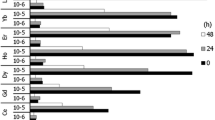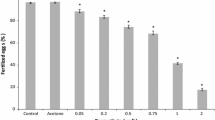Abstract
The gametes, embryos, and early larvae of the surf clamSpisula solidissima were exposed to silver at concentrations up to 65 μg/L. All experiments were conducted at 20°C and 30‰ S, and lasted up to 48 hr after fertilization. Forty-five minute exposures of eggs to 16 μg/L or more silver just prior to fertilization in non-silver seawater lead to production of abnormal larvae. Simultaneous exposures of eggs and sperm to silver concentrations up to 21 μg/L for 45 min did not prevent fertilization but did produce abnormal larvae at silver concentrations greater than 6 μg/L. Postfertilization treatments of zygotes, embryos, and larvae lead to fewer abnormalities than prefertilization or fertilization treatments of comparable exposure length and concentration. The greatest numbers of abnormalities and mortalities were observed in continuous exposures, from gametes through fertilization to 48 hr postfertilization. Variability in % normal development was greater in high than in low silver concentrations.
Similar content being viewed by others
References
Burovina IV, Motavkin PA, Pivovarova NB, Skul'skii IA (1981) Effect of copper on fertilization and ion composition of oocytes of the sea urchinStrongylocentrotus nudus. Biol Morya 6:61–67
Calabrese A, Collier RS, Nelson DA, MacInnes JR (1973) The toxicity of heavy metals to embryos of the American oysterCrassostrea virginica. Mar Biol 18:162–166
Calabrese A, Nelson DA (1974) Inhibition of embryonic development of the hard clam,Mercenaria mercenaria, by heavy metals. Bull Environ Contam Toxicol 11:92–97
Calabrese A, Thurberg FP, Gould E (1977) Effects of cadmium, mercury, and silver on marine animals. Mar Fish Rev 39:5–11
Eagle GA (1981) Study of sublethal effects of trace metals on marine organisms-the need for some standardization. Mar Environ Res 5:181–194
Eyster LS, Morse MP (in press) Early shell formation during molluscan embryogenesis, with new studies on the surf clam,Spisula solidissima. Amer Zool
Goldberg R (1980) Biological and technological studies on the aquaculture of yearling surf clams, Part 1: aquacultural production. Proc Nat Shellfish Assoc 70:55–60
Greenwood PJ, Bennett T (1981) Some effects of temperature-salinity combinations on the early development of the sea urchinParechinus angulosus (Leske). Fertilization. J Exp Mar Biol Ecol 51:119–131
Heslinga GA (1976) Effects of copper on the coral reef echinoidEchinometra mathaei. Mar Biol 35:155–160
Kobayashi N (1980) Comparative sensitivity of various developmental stages of sea urchins to some chemicals. Mar Biol 58:163–171
Lima AR, Curtis C, Hammermeister DE, Call DJ, Felhaber TA (1982) Acute toxicity of silver to selected fish and invertebrates. Bull Environ Contam Toxicol 29:184–189
Loosanoff VL, Davis HC (1963) Rearing of bivalve mollusks In: Russell FS (ed) Advances in marine biology, Academic Press, London pp 1–136
Moore SF, Dwyer RL (1974) Effects of oil on marine organisms: a critical assessment of published data. Water Res 8:819–827
Pagano G, Esposito A, Giordano GG (1982) Fertilization and larval development in sea urchins following exposure of gametes and embryos to cadmium. Arch Environ Contam Toxical 11:47–55
Pechenik JA (in press) Predicting the consequences of water-soluble pollutant input into the marine environment. Hazardous Waste
Rose CD, Heath E (1978) Viability of American oyster,Crassostrea virginica, spermatozoa exposed to stress. Estuaries 1:245–251
Rutherford F, Church TM (1975) Use of silver and zinc to trace sewage sludge dispersal in coastal waters. In: Church TM (ed) Marine chemistry in the coastal environment. American Chemical Society, Washington, DC pp. 440–452
Waldichuk M (1974) Some biological concerns in heavy metals pollution. In: Vernberg FJ, Vernberg WB (eds) Pollution and physiology of marine organisms. Academic Press, New York pp. 1–58
Author information
Authors and Affiliations
Rights and permissions
About this article
Cite this article
Eyster, L.S., Morse, M.P. Development of the surf clam (Spisula solidissima) following exposure of gametes, embryos, and larvae to silver. Arch. Environ. Contam. Toxicol. 13, 641–646 (1984). https://doi.org/10.1007/BF01056344
Received:
Revised:
Issue Date:
DOI: https://doi.org/10.1007/BF01056344




